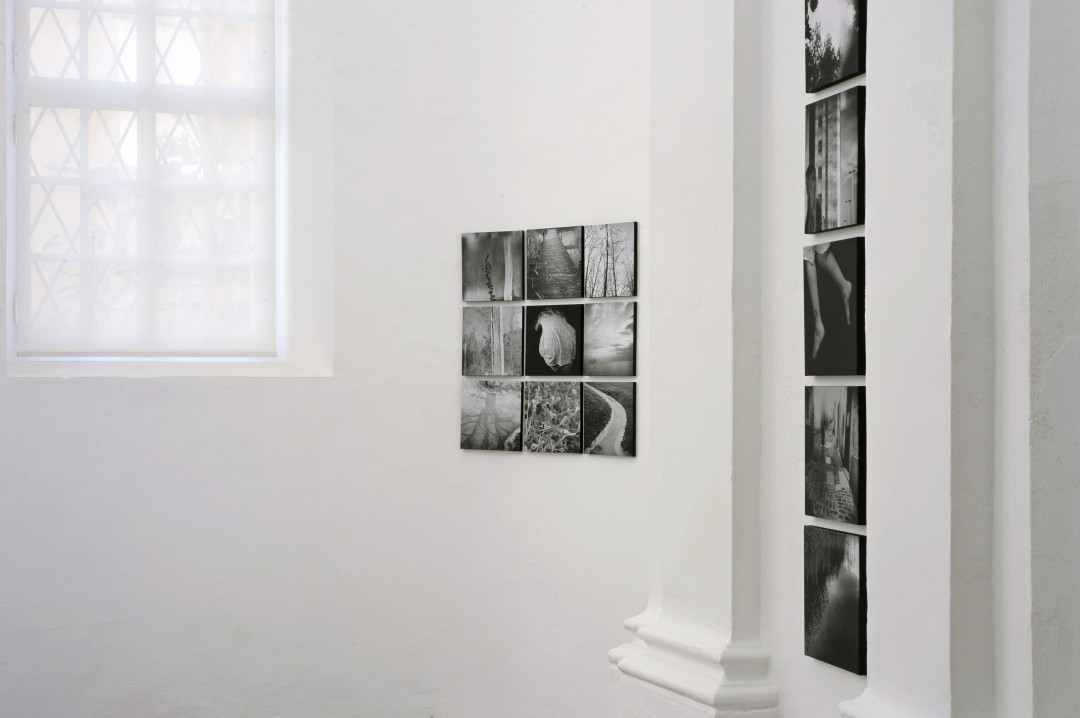Krško Gallery
Valvasorjevo nabrežje 4
8270 Krško
September 28th - November 4th 2018
Arven Šakti Kralj Szomi is a visual artist with a degree from Goldsmith College, University of London, and a master’s degree from the Academy of Fine Arts and Design, University of Ljubljana. Within the Slovenian cultural arena, she is also active as a university lecturer, a member of professional juries and committees, and a translator of expert texts on the arts from Slovene into English. As a visual artist, her work revolves around photography, she ventures into video, expresses herself with drawing and artist’s books, as well as installation-based projects.
Over the recent years, we have seen her work develop through several series of black and white staged photographs in which she explored the subject of childhood, more precisely the pre-adolescent phase of girlhood, the transition to the world of adulthood and the fears that accompany this process. The motifs that the artist intuitively recognizes as thoughts, memories or feelings are found in everyday life. Her photographs therefore appear as diary entries or reflections of private life, to which the artist finds an appropriate equivalent in the form of a visual image. In the spring, she also presented herself at Ljubljana’s Lek Gallery with a series of colour photographs, which she combined into compositions of two or three following the principle of collage. This work was also marked by the quest for the unusual in the everyday moments of life.
A new photographic story is being presented this time at the Krško Gallery by the artist, which continues to explore the theme of girlhood, as the figure of the girl faces the transition between childlike reverie about the world and the actual reception of the messages through which the individual forms within society. The spatial layout consists of fifty-five black and white photographs, arranged in seven so-called sentences or sets of narrative. The photographs within each set intertwine, bearing directly identifiable metaphors upon which the artist builds her narrative. In reading, we may latch onto the artist’s clues in the form of titles: Dreams, Lights and Shadows. The Dreams set makes up the central part of the installation in the former presbytery of the gallery space and, out of the three, refers to the literary model of Lewis Carroll’s Alice in Wonderland to the greatest extent. We recognize the elements that awaken the associations to the story: the rabbit, exotic flora, the chessboard and the hole through which Alice journeyed to Wonderland. The girl moves around a zone that seems to have abandoned the laws of physicality. She is anchored into reality through the Lights and Shadows, the sets on either side, the properties of the earthly, which we often encounter in the work of the artist in a dual relationship. Light, the inherent property of photography that illuminates spaces and gives shape to objects, does not exist without shadows and vice versa. Between the two, in the twilight zone, dreams are manifested, which call us back into the conscious experience like the shards of the waking world.
The photographs are arranged into gridded jigsaw puzzles within which mental associations are formed. The figure of the girl appears as a link between the fragmented scenes of natural settings, architecture and animals. The scenes are rarely captured in their completeness, making it impossible to identify the location of the photograph. It seems as if we are looking at images from dreams, an environment that triggers the feelings of discomfort and uncertainty. Among these, scenes from the urban environment appear, which bring the viewer’s attention back from the world of dreams to the present time, here and now. The girl, who is the bearer of the story, is no longer a dreamy young girl, she is beginning to be aware of the space that she inhabits and looks for her place in it.
The fleeting manner in which the photographs have been taken, the square format of the photographic images and their grid arrangement remind us of the Instagram online platform, where the user announces the events of his life via his smartphone even before they have come to completion. The grid structure of the mobile application is perfectly suited for quickly reviewing any published photographs. The viewer’s gaze is retained by a particular photograph only for a brief moment, as new images appear demanding his attention. The idea of Instagram is altered as it is transferred into the gallery space, into the field of the installed exhibition. The grid structure in the gallery offers a view of all the photographs at the same time. The viewer no longer scans the digital photographs by sliding his finger across a glass screen since, arrested on the gallery wall, they have become physical objects, museum pieces, upon which we bestow our attention and the time to read them.
Arven Šakti Kralj Szomi (1974, Kranj) graduated from Goldsmiths College, University of London, in Fine Art – Studio Practice and Contemporary Critical Theory in the class of Paul Bush and Jayne Parker. She was awarded the title of “University Graduate Designer of Visual Communications” from the Academy of Fine Arts and Design, University of Ljubljana, and completed a master’s degree at the same Academy under the supervision of Srečo Dragan in the Department of Video and Milan Pajk in the Department of Photography. She has shown her work in many selected solo and group exhibitions across Slovenia and internationally over the recent years. She has been a member of the ZDSLU Association of Artists since 2004 and has also worked as a self-employed artist accredited by the Ministry of Culture since then. This year, the Ministry awarded her with a work grant for her book project The Girl of the Aster Flower. Her works are part of private and public collections at home and abroad, including the Imago Mundi – Luciano Benetton Collection and the collection of the Museum and Galleries of the City of Ljubljana.
Ambient photographs: Nina Sotelšek
